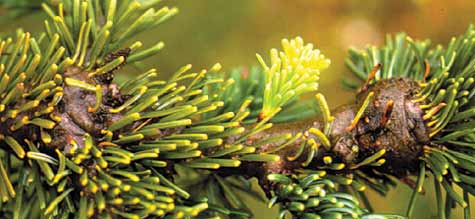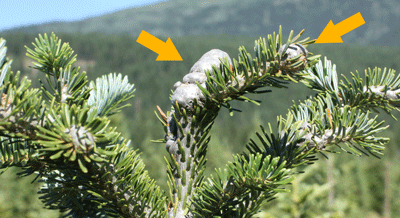Balsam Woolly Adelgid
The balsam woolly adelgid, Adelges piceae (Ratz.), was accidentally introduced to North America from Europe. The adelgid is an inconspicuous, aphid-like pest that appears as white, woolly masses about 1 mm long on the bark.
Due to their small size, they can be easily overlooked in the early stages of an infestation. They feed exclusively on true firs (Abies species). Despite its small size, it is an extremely destructive pest that can kill a tree after several years of heavy feeding. This is especially true for subalpine fir (Abies lasiocarpa).

Female with eggs, overwintering nymph, and crawler.
Symptoms
The balsam woolly adelgid injects saliva into its host plant when feeding. The saliva is toxic to the plant and inhibits bud formation and causes long-term tree decline. Symptoms of adelgid feeding include needle yellowing and premature needle loss, and swelling of branch nodes and terminal buds.

Balsam woolly adelgid damage to fir.
Life Cycle
The adelgid has two to four generations per year. The wingless female can produce in excess of 200 amber colored eggs. The eggs are laid under masses of "cottony tufts" on the underside of branches and on the trunk. Crawlers are visible with the aid of a hand lens beginning around bud break. This stage is the most susceptible to chemical control. There are no males, hence females give rise to more females.
Terminal bud of Fraser Fir showing advanced symptoms.
Host and Geographical Range
Balsam woolly adelgid attacks only Abies or true fir species. North American species are the most sensitive to attack, led by Fraser fir, Subalpine fir, Balsam fir and Shasta fir. Grand and Amabilis firs are less susceptible. European silver fir is relatively resistant.
The adelgid is an important pest of true firs in the Atlantic provinces, the NE and NW United States and SW British Columbia. There is tremendous concern it will spread into the Interior and infest the very important and widely distributed subalpine fir forests. Unfortunately, in recent years, this pest has moved into wild forests and managed tree farms across southern B.C.
Management
While there is no longer a provincial regulation or federal order restricting the movement of Abies in BC or across provincial and international borders (repealed in 2019), we encourage growers and silviculturists to take steps to prevent introductions to their fields and sites. A basic best management program should include:
- Access Abies seedlings and trees from clean local sources where at all possible, so as not to introduce BWA into a new planting.
- Discourage moving Abies trees from one region to another, to limit new introductions as much as possible.
- Cull and destroy any severely infested Abies trees when symptoms are first noticed. Do not move infested or culled trees during the summer, as this can spread the BWA crawlers to new trees.
- Insecticides used for aphid control and other pests may help decrease BWA levels and subsequent damage to the trees.
- Contact your grower association, BC Ministry of Agriculture or BC Ministry of Forests Lands and Resource Operations and Rural Development for more information on pest biology and best management practices.
Canadian Forest Service Information
Contact information
AgriService BC
Have a question? Call or email us.
Telephone: 1 888 221-7141
E-mail: AgriServiceBC@gov.bc.ca

